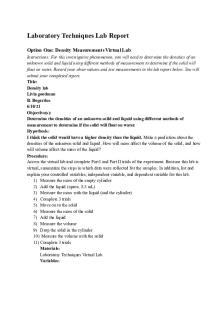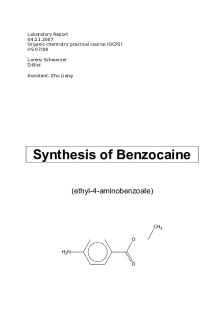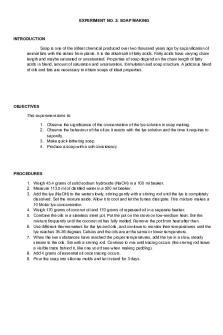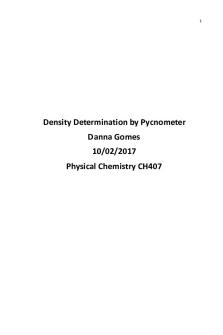Benzocaine (2 steps) - Laboratory Report PDF

| Title | Benzocaine (2 steps) - Laboratory Report |
|---|---|
| Author | Harrison Levine |
| Course | Organic Chemistry La 4W2 |
| Institution | University at Albany |
| Pages | 12 |
| File Size | 728.8 KB |
| File Type | |
| Total Downloads | 107 |
| Total Views | 206 |
Summary
The Synthesis of benzocaine ...
Description
Laboratory Report 04.11.2007 Organic chemistry practical course (OCP1) HS 07/08 Lorenz Schwarzer D-Biol Assistant: Zhu Liang
Synthesis of Benzocaine (ethyl-4-aminobenzoate)
CH3 O H2N O
Method 1. Reduction of aromatic para-nitrobenzoic acid by tin to para-aminobenzoic acid 2. Esterification of para-aminobenzoic acid by sulphuric acid and ethanol to benzocaine
1. Reduction Reaction equation O
OH
OH
Sn H2N
N O
O
O
3Sn C7NO4H + 6H+ + 6e-
→ →
3Sn2+ + 2eC7NO2H3 + 2H2O
3Sn + C7NO4H + 6H+
→
3Sn2+ + C7NO2H3 + 2H2O
2NH3 + 2H2O + 2Sn2+
→
Sn(OH)2 + 2NH4+
Physical properties of the substances Para-nitrobenzoic acid
O
OH
Molar weight Density Melting point Boiling point R-Phrases
R22 R41
N O
O
S-Phrases
S26 S39
167.12 g/mol 1.58 g/ml 237 °C Sublimes °C Harmful if swallowed. Risk of serious damage to the eyes. In case of contact with eyes, rinse immediately with plenty of water and seek medical advice. Wear eye / face protection.
Tin Molar weight
118.71 2
g/mol
Density Melting point Boiling point R-Phrases S-Phrases Hydrochloric acid (conc.) Molar weight Density Melting point Boiling point H-Cl R-Phrases Sn
R 34 R 36 R 37 R 38 S 26
S-Phrases
7.265 231.93 2602
g/ml °C °C
36.46 1.19 -40 84
g/mol g/ml °C °C
Causes burns Irritating to eyes Irritating to respiratory system Irritating to skin In case of contact with eyes, rinse immediately with plenty of water and seek medical advice.
Ammonia
H H
Molar weight Density Melting point Boiling point R-Phrases
17.03 0.69 -77.73 -33.34
g/mol g/ml °C °C
R10 R23 R34 R50 S1/2
Flammable Toxic by inhalation Causes burns Very toxic to aquatic organism Keep locked up and out of the reach of children S16 Keep away from sources of ignition – no smoking S36/37/39 Wear suitable protective clothing, gloves and eye/face protection
N H
S-Phrases
Para-aminobenzoic acid (PABA) Molar weight Density OH Melting point H2N Boiling point R-Phrases O S-Phrases
137.14 1.37 187-189 -
g/mol g/ml °C °C
Educts Substance p-nitrobenzoic acid
Amount
Molar amount g 2.89
mol 0.018 3
Volume ml -
Tin Hydrochloric acid
7.04 ~13
0.059 0.41
~15
Experimental accomplishment 1. 2.89g p-nitrobenzoic acid, 7.04g Tin (little balls) and 15ml conc. HCl were put in a round bottom flask (fitted with a reflux condenser). The mixture was heated up to 115°C for about 20min (caution gases). The solution becomes clear. 2. The solution is decanted and the remaining tin washed with water and decanted again. 3. With conc. Ammonia the solution is adjusted to pH 9, and then it was heated up again for 20min. Filtered with vacuum. 4. The solvent was evaporated with vacuum. 5. The crystals were recristallized from ethanol/water (2:8)
Experimental setup
Reflux condenser
Thermometer
Filter Oilbath 4 3 21
5 6 7 8 1 19
4 3 2
1
5 6 7 8 9 1 0
Vacuum
Heating apparatus
Filtration apparatus
4
Results IR-Spectrum-bands [cm-1]
3250-3400 1690-1760 1540
N-H stretch (amines) C=O stretch (carboxylic acid) NO2 stretch (nitro compounds)
If you compare the IR-spectrum of the product with the Reference spectrums of paminobenzoic acid and p-nitrobenzoic acid, you can see that most of the product is still p-nitrobenzoic acid. The reduction of p-nitrobenzoic acid didn’t go well. One reason could be that we used tin as balls instead of powdered tin. For the esterification of the p-aminobenzoic (PABA) acid to benzocaine I had to take some PABA from the Assistant IR-Spectrum of the Product
5
Reference IR-spectrum of p-aminobenzoic acid
Reference IR-spectrum of p-nitrobenzoic acid
6
2. Esterification Reaction equation CH3 OH
O H 2S O
H2N
4
/ E tO H H2N
O
O
Mechanism
7
CH3 CH3
O
O
+
HO
OH
OH
HO +
OH
C
H
+
H
OH
HO HO
O
OH
CH3
+
NH2
NH2
NH2
NH2
NH2
Physical properties of the substances Ethanol
OH H3C
Molar weight Density Melting point Boiling point R-Phrases S-Phrases
46,07 0.79 -114.4 78.37 R11 S7 S16
g/mol g/ml °C °C
Highly flammable Keep container tightly closed Keep away from sources of ignition
Sulfuric acid (H2SO4)
HO O
Molar weight Density Melting point Boiling point R-Phrases S-Phrases
98,07 g/mol 1.84 g/ml 10 °C 338 °C R35 Causes severe burns S1/2 Keep locked up and out of the reach of children S26 In case of contact with eyes, rinse immediately with plenty of water and seek medical advice. S30 Never add water to this product S45 In case of accident or if you feel unwell, seek medical advice immediately
S O OH
8
Sodium Carbonate (Na2CO3) Molar weight Density Melting point + O + Boiling point Na Na R-Phrases S-Phrases O O
R36 S22 S26
105.99 g/mol 2.5 g/ml 851 °C decomposes °C Irritating to eyes Do not breathe dust In case of contact with eyes, rinse immediately with plenty of water and seek medical advice
Benzocaine
CH3
Molar weight Density Melting point Boiling point R-Phrases
165.19 g/mol 1.17 g/ml 89-92 °C 172 °C R36/37/38 Irritating to eyes, respiratory system and skin R43 May cause sensitization by skin contact S24 Avoid contact with skin S26 In case of contact with eyes, rinse immediately with plenty of water and seek medical advice S37/39 Wear suitable gloves and eye / face protection
O H2N O
S-Phrases
Educts Substance p-aminobenzoic acid Ethanol Sulfuric acid
Amount
Molar amount g 3.12 ~19 ~0.5
mol 0.023 ~0.41 ~0.0055
Volume ml ~15 ~1
Experimental accomplishment 1. 3.12g PABA from the Assistant (reduction didn’t work), 15ml of ethanol and 1ml of H2SO4 were added to a bottom flask. The Solution was heated under reflux for 2h (with stirrer). 9
2. Then cooled down and neutralized with 10% Na2CO3 until the pH was over 9. 3. Extracted with ether in the separation funnel. Dried with sodium sulphate. 4. The ether and ethanol were evaporated. A white powder appeared.
Experimental setup
Reflux condenser
Thermometer
Oilbath 4 3 21
5 6 7 8 1 19
3 2
4 1
5 6 7 8 9 1 0
Heating apparatus
Separation funnel
Results Melting point
Token: Benzocaine (literature): PABA (literature):
IR-Spectrum-bands [cm-1]
3250-3400 1735-1750 1690-1760
89.7°C 89-92°C 187-189°C N-H stretch (amines) C=O stretch (esters) C=O stretch (carboxylic acids)
With the aid of the comparisons of the token IR-spectrum with the reference spectrum, it is not clear if the product is PABA or Benzocaine, but if you compare the token melting point with the literature values of BABA and Benzocaine, the product can be identified as benzocaine. 10
IR-Spectrum of the Product
Reference IR-spectrum of benzocaine
11
Literature
CrossFire Beilstein http://riodb01.ibase.aist.go.jp/sdbs/cgi-bin/cre_index.cgi?lang=eng http://en.wikipedia.org http://www.chemexper.com http://www.chemblink.com
12...
Similar Free PDFs

Benzocaine Lab Report
- 6 Pages

Lab 1 - Laboratory Report
- 10 Pages

Laboratory+report+1-4
- 11 Pages

Laboratory 11 - Lab Report
- 3 Pages

Laboratory report - aspirin
- 8 Pages

Laboratory Report 1 SKO3023
- 30 Pages

Laboratory Report Rubric
- 2 Pages

Laboratory Techniques Lab Report
- 4 Pages

LABORATORY REPORT EXPERIMENT 5
- 6 Pages

A&P I Laboratory Report 2 2021
- 2 Pages

Laboratory report for BIO
- 4 Pages
Popular Institutions
- Tinajero National High School - Annex
- Politeknik Caltex Riau
- Yokohama City University
- SGT University
- University of Al-Qadisiyah
- Divine Word College of Vigan
- Techniek College Rotterdam
- Universidade de Santiago
- Universiti Teknologi MARA Cawangan Johor Kampus Pasir Gudang
- Poltekkes Kemenkes Yogyakarta
- Baguio City National High School
- Colegio san marcos
- preparatoria uno
- Centro de Bachillerato Tecnológico Industrial y de Servicios No. 107
- Dalian Maritime University
- Quang Trung Secondary School
- Colegio Tecnológico en Informática
- Corporación Regional de Educación Superior
- Grupo CEDVA
- Dar Al Uloom University
- Centro de Estudios Preuniversitarios de la Universidad Nacional de Ingeniería
- 上智大学
- Aakash International School, Nuna Majara
- San Felipe Neri Catholic School
- Kang Chiao International School - New Taipei City
- Misamis Occidental National High School
- Institución Educativa Escuela Normal Juan Ladrilleros
- Kolehiyo ng Pantukan
- Batanes State College
- Instituto Continental
- Sekolah Menengah Kejuruan Kesehatan Kaltara (Tarakan)
- Colegio de La Inmaculada Concepcion - Cebu




